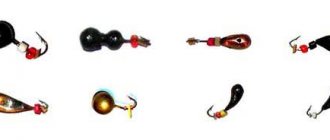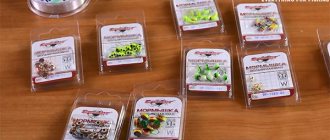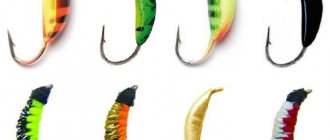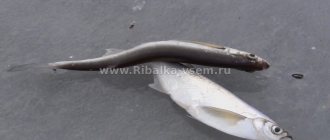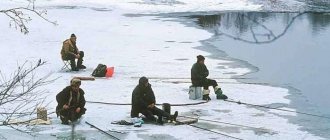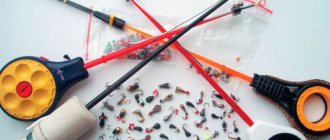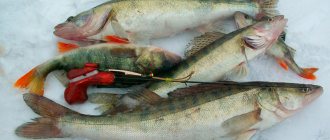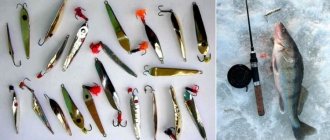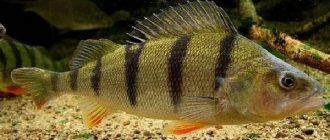Among all the inhabitants of the underwater kingdom in all fishing seasons, one of the most long-awaited trophies among fishing enthusiasts is His Majesty bream. Catching bream in winter with a jig can be an extremely exciting activity, you just have to approach it thoroughly and with knowledge of many nuances, which we will talk about in this article.
Choosing a fishing spot
In winter, bream prefers to stay in areas with running water and deep water. The main winter sites for this fish are:
- Channel pits on reaches, in bays;
- Deep and elongated ditches (“troughs”) under steep banks;
- Upper edges of channel ditches;
- Level platforms (“steps”) separating the upper edge of one slope from the lower edge of another;
Most often, bream in winter is found in places with a muddy, clayey or pebble bottom - this diversity in the nature of the bottom preferred by fish at a given time is associated with the presence of such food items as bloodworms in muddy sediments or zebra mussels that live on stones and other solid objects.
When is the best time to catch bream in winter?
The activity of fish in winter is very dependent on the concentration of dissolved oxygen in the water. And since this indicator, as aquatic vegetation dies off, decomposes with the absorption of a large amount of this element and the release of destructive carbon dioxide, and the growth of the ice shell, first decreases, and then, as spring approaches and the ice melts, it begins to increase again, the activity also changes fish.
December
On the first ice, bream should be looked for near deep wintering holes, under steep banks, on dumps and upper edges of the riverbed, on “tables” surrounded on all sides by great depths.
At the same time, bream and small bream in search of food at this time often visit shallow water areas with depths of up to 2-3 meters. Most often this happens in the morning.
Bream is caught at this time using large or medium lead or tin jigs, while experimenting with the color of the bait. A bunch of 3-5 bloodworms is used as a nozzle.
Compulsory feeding, both this month and in subsequent months, is complementary feeding. The mixture is thrown into the hole in small portions - at this time the main thing is to attract the bream to the hole and hold it, and not overfeed.
Video on catching bream with a jig in winter:
January
In the dead of winter, bream is little active. Almost all the time it stays at depths of more than 4-6 meters, looking for food on the “tables” and “navels” adjacent to them. It feeds most actively in January at night - from 10-11 o'clock at night until 4-5 o'clock in the morning. At this time, it is caught using small but heavy tungsten jigs 2-3 mm long with the addition of bloodworms and mandatory feeding using dump feeders.
February
In the first half of the month, when severe frosts persist, bream behaves quite passively. However, by the beginning of the third decade, with gradual warming and the beginning of the destruction of the ice cover, the flow of melt water saturated with oxygen under the ice, the fish begin to show greater activity than in the deep winter. At this time, it feeds more intensively and moves around the reservoir, leaving deep holes, often entering relatively shallow areas with shallow depths near the confluence of streams and small rivers.
With a warm spring and rapid warming towards the end of the month, schools of bream leave deep wintering holes and move to the mouths of small rivers.
Bream is caught in February using jigs of various sizes and weights. As in other months, the main bait is bloodworms. They feed him at this time not as actively and plentifully as in January. At shallow depths they feed by throwing the bait mixture directly into the hole; dump truck feeders are used in the pits.
The best tackle for catching bream in winter
Fishing rod
The most convenient when catching bream with a jig are balalaika-type fishing rods made of dense foam, lightweight frost-resistant plastic, and cork. The whip of such a fishing rod and the reel should be painted in bright contrasting colors, allowing, if necessary, to throw the fishing rod away from the hole and quickly find it against a white background of snow.
fishing line
In winter bream fishing, only monofilament fishing line is used. Braided cords are not used due to their excessive rigidity and rapid freezing.
The thickness of the fishing line used depends on the experience of the fisherman and the expected weight of the fish that will have to be fished:
- Beginners in this kind of fishing are advised to use a fishing line with a cross-section of 0.10-0.12 mm;
- Experienced fishermen most often fish with thin and strong fishing lines with a cross-section of 0.08-0.10 mm;
In order to quickly find it on the ice when landing fish and removing the fishing line from the hole, it is recommended to use dark-colored monofilament.
Nod
Nods for jig tackle for bream use lavsan 8-10 cm long with such a rigidity that, under the influence of the gravity of the jig tied to the fishing line, it bent relative to the unloaded state by about 300.
As practice has shown, the most sensitive and best transmit vibrations of the fisherman’s hand to the jig are nods, in which, instead of a separate large and often made from a piece of insulation, a through-ring has a small hole at the end.
Fishing with Mormyshka: Technique and Tactics
Practice has repeatedly proven that the techniques for using a jig can be different:
- For example , today the fish takes jigs during active play; - Tomorrow - with sluggish play with a jig; - Well, the day after tomorrow , even with her barely noticeable hesitation. Therefore, you have to constantly change your fishing tactics depending on the “mood” of the fish.
And yet, despite such a large assortment of a wide variety of jigs, the most important thing is that the jig is heavy (has maximum weight) and at the same time has a minimum size. The best jigs are mainly made from various alloys of heavy metals, whose specific gravity is much higher than that of lead.
“Tungsten” jigs are in first place in popularity among winter fishermen, since the specific gravity of tungsten exceeds the specific gravity of lead several times. For a beginning winter angler, it will be enough to have in his arsenal such jigs as:
— Klopik ; — Drobinka ; - Ural ; - Oatmeal ; - Droplet ; - and etc.
Over time, each fisherman himself will determine and select for himself those jigs that are most dear to him. When fishing with a jig, the bite signal is a special nod, which is attached to the tip of the rod, and through which the fishing line is threaded. The nod is so sensitive that the slightest touch of a fish, even a very small one, can be seen from it.
If the nod suddenly wavers or bends, a short hook should immediately follow. Nods for winter fishing are sold in fishing stores. They differ in shape, length and rigidity. Many experienced fishermen make them with their own hands, from various materials.
The Most Important Thing in the Nod Work:
— So that the fishing line passes through it freely; — The nod itself would not break from constant impacts on the ice; — It was constantly elastic, like a spring, regardless of the air temperature.
To the question : Which fishing line is better to use when fishing with a jig? Let's answer this: The diameter of the fishing line for jig fishing depends on several factors, namely:
— Depths at the fishing site; — The weight of the jig itself; — Size of fish caught.
The principle, as with any equipment, remains the same: the thinner the line, the better! Of course, it is desirable that it does not tear with every hook. The most popular working line diameter in jig fishing is 0.12 - 0.16 mm. This is not a panacea, but only approximate data, since the quality of the fishing lines used is improving every year. Consequently, thinner and higher quality fishing lines are used every year.
How to Catch the Devil. One of the Most Catchable Jigs (Video)
How to choose a jig for bream
Bream are caught using both baited and reelless (sports) jigs.
The difference between the first baits and the second is that the jigs, which use bloodworms, hang vertically in the water column; baitless ones, or as they are often called “reelless” ones, are located in the water at a slight angle and when playing, thanks to this arrangement, they create additional nodding movements that attract fish. Catching models of jigs
Among the baits used for catching bream in winter, the most catchy jigs are:
- “Drop” is a bait that has a shape corresponding to its name with a hook soldered into the tapering part. There are such jigs in silver, golden or, less commonly, black. The bait is attached to the fishing line using a hook eye protruding from the body or a hole in it.
- “Nymph” is an elongated bait with a convex outer surface and an almost flat inner surface adjacent to the hook with small ribs on the surface. The outer surface is usually dark in color, the inner surface is golden or silver. The bait is attached to the fishing line by the hook eye protruding from its body.
- “Devil” is an elongated and sometimes rod-shaped bait with a treble hook soldered into the narrow part. It is most often tied to the fishing line using a through hole in the body of the bait, less often by the tee eye protruding from the jig.
- “Ant” is a jig shaped like the insect of the same name. The bait is attached to the fishing line exclusively through the axial hole. The jig is available in various colors and sizes.
Types of jigs
Varieties of jigs
In fishing stores you can find a huge number of jigs; they simply amaze with their incredible configuration and efficiency.
All these products can be distinguished:
- By color. In stores you can find sets of different types with a huge number of shades. There are many craftsmen who create their own variations; to purchase these, you can visit fishing forums in your region.
- By weight.
- According to the option of attaching to a fishing line.
- According to the form.
If you look at jigs in the shape of a ball, they are not capable of creating a game under water. Only if you make up and down movements, the hook with bait deviates a little. Such gear can attract fish that live near the bottom line.
Winter fishing with a reelless jig is considered very popular, since such tackle performs well when the fishing rod moves. This behavior of the jig is justified by its drop-shaped shape.Read here What you need for winter fishing - tips and tricks for fishing beginners and a minimum list of necessary equipment (125 photos + video)
Flat variations of the same tackle allow you to smoothly vary to the side when moving the fishing rod. The basic technique consists of smooth and slow twitching, such movements strongly attract many inhabitants of different bodies of water.
Faceted jigs are often used for fishing in light or slightly turbid water. Their main advantage lies in their edges, which are often made of copper or silver.
The light in the water is refracted and reflected from the edges of the jig, it begins to sparkle, this attracts the fish, forcing it to grab easily accessible prey.
For a detailed look at how such gear is used, you can watch a video of winter jig fishing.
When fishing is carried out at great depths, approximately 5 meters or more, then tungsten jigs should be used.
Their main advantage is that they drop to the required depth in a short time, and all movements are sent to the nod.How to tie a jig
There are several ways to attach a jig to a fishing line:
- When tying a jig, a fishing line equipped with an eyelet is passed through it, then it is made 5-8 turns around the main thread and the end is passed into the resulting ring of the resulting twist near the eyelet and the knot is tightened.
- In baits without an eye, the line is passed through a thin hole in the middle of the body of the jig, made 5-6 turns around the shank of the hook, then passed through the hole again, but in the opposite direction. A simple knot is tied on the elongated tip as close to the edge as possible, after which, by pulling the main thread, it is locked in the hole in the body of the jig, thus fixing the bait on the fishing line.
- The most universal and simple knot, which at the same time has great strength, is a connection that is knitted in the following sequence: the fishing line is passed with a reserve into the ring or hole in the body of the jig, then it is folded in half, the resulting loop is placed between the thumb and index finger of the right hand and their movements a kind of twist is formed in opposite directions, which is put on the hook. The knot is tightened by pulling the tip of the fishing line protruding from the twist. A similar operation with the formation of a twist and its fixation on the underwear is repeated 2-3 times. The remaining tip must be carefully trimmed.
Three ways to tie a jig to a fishing line, watch:
Bait of bream
Many fishermen prefer purchased bait mixtures to those that they make themselves according to recipes that have been proven over the years.
Among the huge variety of such recipes, the following recipes are characterized by the greatest effectiveness in attracting bream and at the same time ease of preparation:
Recipe No. 1
4 main ingredients
Composition:
- Peas – 320 grams;
- Oatmeal (“Hercules”) – 120 grams;
- Sunflower seeds – 120 grams;
- Breadcrumbs – 400 grams;
Cooking method
Soak the peas for 4-5 hours and boil until mushy. Grind oatmeal and seeds in a coffee grinder or meat grinder, add breadcrumbs and mix thoroughly.
After a fairly homogeneous granular mass has been obtained, boiled peas are added to it and, again, thoroughly mixed, the finished bait is obtained. Store this mixture in a simple plastic bag or large container.
Recipe No. 2
Compound:
- Sunflower seeds – 400-450 grams;
- Brown bread crackers – 400 grams;
- Semolina – 200 grams;
Cooking method
Crackers are made from scraps of black rye bread - for this, it is cut into small slices and dried near a radiator or at low temperature in the oven. Rusks are ground in a meat grinder, seeds - in a household coffee grinder. All components are poured into a large spacious container and mixed thoroughly. Store dry in plastic bags or special containers. In winter, water from the hole is added to this bait to give it weight and viscosity.
Recipe No. 3
Compound:
- Barley groats – 400 grams;
- Sunflower seeds – 200 grams;
- Hemp seeds – 200 grams;
- Wheat flour – 100 grams
- Coconut flakes – 100 grams;
Cooking method
Barley groats are boiled in a small amount of water and allowed to settle and thicken. Roasted sunflower and hemp seeds are thoroughly ground in a meat grinder or coffee grinder, the resulting powdered compositions are mixed together, and a small amount of coconut is added to the settled barley porridge. In order to add viscosity and density to the bait when diluting it with water, add a little wheat flour.
Watch a video on catching bream with a jig in winter:
Fishing technique
The technique for catching winter bream involves using the most suitable bait and using the correct bait action.
Playing with a jig
The technique of playing with a jig when fishing for bream is somewhat different from that used for perch or roach
- The jig is slowly lowered to the bottom;
- Before starting the main game, it is recommended to lift the jig 3-5 cm above the bottom and release it sharply - this technique is called “knocking” on the bottom. In areas where there is a small silt or fine sandstone at the bottom, with the help of such manipulations you can create a small cloud of turbidity that is attractive to fish.
- After several hits have been made on the bottom, they begin a slow rise to a height of 1-1.5 above the bottom, giving the bait smooth and low-amplitude vibrations. Every 20-30 cm of such a rise, as a rule, they take a fairly long 3-5 second pause, during which bites very often occur.
- After the jig is raised to a sufficiently high height above the bottom, they begin to lower the bait just as smoothly, performing the same oscillations and pauses as when lifting.
When catching bream with a jig, you should not perform very high-speed movements with a high frequency of oscillation of the jig and short pauses. This game will attract small and medium-sized perch, ruff, and small bream. Large bream - cautious and vigilant - will not be tempted by bait moving at such a pace very often.
Popular Jigs for Winter Fishing
All jigs are classified not only according to the Principle of Location on the Line:
— Horizontal; — Inclined.
Also by Weight:
— Light (less than 0.4 g); — Medium (from 0.5 to 1 g); — Heavy (over 1 year).
And by Size:
— Small (about the size of a match head); — Medium – about 2.5-3 mm; — Large – 4 mm or more.
They also differ in Their Form:
— Drop-shaped; — Flat-oval; — Ball; — Conical; - Faceted.
By Color:
— Light; - Dark.
Winter jig fishing has a huge variety of different techniques and fishing techniques. Here are a few of them:
— The jig is simply pulled upward smoothly; — The jig is smoothly pulled upward, slightly tugging with the tip of the rod; — Simply tap the jig on the bottom, shaking the rod; - And many others.
It is impossible to advise a novice fisherman on one particular fishing line and say that it is the most catchy. Everything is learned through comparison and experimentation. But, for starters, you can still try these techniques (until you choose the most acceptable one):
— We lower the jig to the bottom and slowly lift it up, while slightly shaking the tip of the rod. The signal for the jig to sink to the bottom will be the straightening of the guard (nod) and the weakening of the fishing line;
- After you have lowered the jig to the bottom, move it slightly, and then smoothly lift it by 3 - 4 cm;
— Lower the jig to the bottom, then evenly, without the slightest swaying, with the tip of the rod, very slowly lift it up, up to about 40 cm;
— After you have determined in which layer of water the fish bite most often, you should measure the fishing line so that the bait drops exactly to the desired depth, and begin lifting from this point.
To successfully fish with a jig, you need to constantly practice and improve your skills. The skill lies in playing with bait. Once you start catching your first fish with a jig, you will slowly begin to understand the principle of this fishing, and will soon become a real professional in your field.
Features of catching bream with a jig
Winter fishing for bream with a jig has a number of features, without which catching this fish in the cold season is unlikely to be productive and interesting:
- It is necessary to arrive for bream fishing long before dawn - bream fishing grounds are, as a rule, very popular among fishermen, and those who like to sleep may simply not “stick” in the treasured place, which is very tightly drilled by more efficient colleagues.
- At the selected location, about 15-20 holes are made with a distance of about 15-20 meters between them.
- Each hole is fed - the main part of the bait is delivered to the bottom using a large winter feeder-dump truck. It is not recommended to feed the hole by throwing the mixture into it by hand, since in this case it will sink to the bottom and attract a large number of small fish.
- After the bait has been thrown into all the holes, fishing begins with the one that was drilled and fed first.
- 10-15 lifts are performed on each hole. If there are no bites, the tackle is placed in a stationary state for some time (10-15 minutes), raising the jig with bloodworms 5-7 cm above the bottom and placing the fishing rod on a stand next to the hole.
- If there are no bites and there is a “stand”, they move to the next hole.
- If the bite in the holes where large specimens were caught weakens, additional feeding is done - for this, a small amount of bait is rolled into balls of loose consistency and thrown directly into the hole. This is done in order not to frighten the bream located nearby or directly under the hole by the knock of a large feeder on the bottom.
- When fishing, you should not rush and unceremoniously drag the fish to the hole - when fishing, you need to keep the line clamped between two fingers of one hand, and with the other, smoothly select the line and throw it on one side of the fishing spot. With sharp pulls and jerks, this positioning of the hands and laying of the fishing line will allow it to be handed over without the formation of all kinds of tangles and “beards” under some tension, squeezing the thread more tightly between the fingers.
- Particularly large specimens are removed from the hole by hand, carefully inserting it under the gills of the fish.
Fishing with Mormyshka from Ice: Features
Fishing with Mormyshka from Ice has its own characteristics. There is nothing complicated here, and no supernatural knowledge or skills are needed. But there are still some little tricks and subtleties.
One of the most important requirements in jig fishing is its action. Everything will depend on how you play with the jig, that is, with the tip of the rod. But it also happens that the fish does not respond to the game, but is best taken in a standing position, with the addition of bloodworms. Therefore, be sure to try all fishing methods to determine which is more successful.
Table of contents
— Features of Fishing with a Jig ↓ — Fishing with a Jig with Alexey Pugach (Video) ↓ — How to Fish with a Jig. Fishing Techniques and Tactics ↓ — How to Catch the Devil. One of the Most Catchable Jigs (Video) ↓ — What types of jigs are there? ↓ — In winter to Bezmotylka. Tackle, Technique and Tactics of Fishing (Educational film) ↓
Winter Fishing with Mormyshka consists of:
— rod with a whip; — Fishing lines ; - Nod ; - Jigs .
To see a bite, all your attention needs to be focused on the nod (rod tip), since this equipment does not have a float and a sinker. As for jigs, their variety is simply off the charts. Moreover, they differ from each other not only in the material from which they are made, but also in: weight, size, shape and color.
Now you can buy any jig you want in the store. It is also not difficult to make a jig yourself, which is what many fishermen do. It is simply impossible to say in advance which jig will be the most catchy. When going fishing, it is advisable to have 10-15 jigs in your arsenal, varying in weight, material, color and shape.

